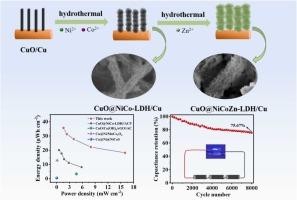在CuO/Cu上原位生长zn掺杂NiCo-LDH纳米片作为同轴柔性不对称超级电容器的电极
IF 6.3
2区 材料科学
Q2 CHEMISTRY, PHYSICAL
引用次数: 0
摘要
提高超级电容器的性能需要开发具有优化纳米结构的新型电极材料。这种电极材料可以通过复合形成和元素掺杂等策略制备。在这项研究中,CuO纳米线最初生长在柔性铜线衬底上,以增加其比表面积并增强其固有的电化学性能。随后,通过水热法合成CuO@NiCoZn-LDH复合材料,其中通过部分取代LDH层内的Ni或Co,将Zn成功掺杂到NiCo-LDH中。制备了未掺杂和掺杂锌的电极材料,以进行形态、结构和电化学分析的比较。Zn的掺杂显著提高了NiCo-LDH的纳米结构尺寸、比表面积和活性位点密度,从而改善了NiCo-LDH的电化学性能。另外,以活性炭纸(ACP)为负极,CuO@NiCoZn-LDH为正极,在最佳条件下制备了同轴柔性超级电容器。在1.6 mW cm⁻²的功率密度下,该装置的能量密度为35.6 μWh cm⁻²,在8000次充放电循环后,其初始比电容仍保持75.67%。这项工作为实现卓越的柔性储能性能提供了有价值的见解。本文章由计算机程序翻译,如有差异,请以英文原文为准。

Zn-doped NiCo-LDH nanoflakes grown in-situ on CuO/Cu as an electrode for coaxial flexible asymmetric supercapacitor
Enhancing supercapacitor performance necessitates the development of novel electrode materials with optimized nanostructures. Such electrode materials can be prepared through strategies like composite formation and elemental doping. In this study, CuO nanowires were initially grown on a flexible copper wire substrate to augment its specific surface area and enhance its intrinsic electrochemical properties. Subsequently, CuO@NiCoZn-LDH composites were synthesized via hydrothermal methods, wherein Zn was successfully doped into NiCo-LDH by partially substituting Ni or Co within the LDH layers. Both undoped and Zn-doped electrode materials were fabricated to enable comparative morphological, structural, and electrochemical analyses. Zn doping significantly increased the nanostructural dimensions, specific surface area, and active site density of NiCo-LDH, thereby improving its electrochemical performance. Additionally, a coaxial flexible supercapacitor was assembled using activated carbon paper (ACP) as the negative electrode and CuO@NiCoZn-LDH prepared under optimal conditions as the positive electrode. This device exhibited an excellent energy density of 35.6 μWh cm⁻² at a power density of 1.6 mW cm⁻², while retaining 75.67% of its initial specific capacitance after 8000 charge-discharge cycles. This work provides valuable insights into achieving superb flexible energy storage performance.
求助全文
通过发布文献求助,成功后即可免费获取论文全文。
去求助
来源期刊

Journal of Alloys and Compounds
工程技术-材料科学:综合
CiteScore
11.10
自引率
14.50%
发文量
5146
审稿时长
67 days
期刊介绍:
The Journal of Alloys and Compounds is intended to serve as an international medium for the publication of work on solid materials comprising compounds as well as alloys. Its great strength lies in the diversity of discipline which it encompasses, drawing together results from materials science, solid-state chemistry and physics.
 求助内容:
求助内容: 应助结果提醒方式:
应助结果提醒方式:


